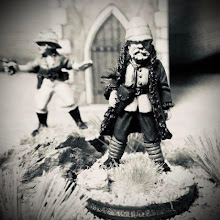I really hate painting gun carriages and wagon spoke type wheels. Whew. I'm glad I got that off my chest.
Imperial Chinese artillery manning a breechloader.
The Chinese Krupp mountain gun Model 1895 is a variant of the 75mm gun which was designed for portability in mountainous regions. It was used by the Chinese in various conflicts; from the First Sino-Japanese War all the way up to World War II. Both the Tenacious Army and the Kansu Braves had the Krupp model 1895.
The cannon is from Askari Miniatures which has many fine lines of artillery and other Colonial miniatures and accessories.
Since it's a breech loader, I am out of a job since I have a linstock used with muzzle loaders. Maybe I can hold a banner when my replacement shows up.











Excellent crew an mountain gun Neil....I feel the same re assembling and painting guns, limbers, wagons etc!
ReplyDeleteA fellow sufferer! If possible I try to do the artillery first so I can enjoy the rest of the painting.
DeleteGreat looking piece of kit. Don't leave home without it.
ReplyDeleteThanks. I’m glad I went with a breech loader as the Guards Army, especially the Tenacious Army and Kansu Braves component, had quite a few.
DeleteGreat looking crew and gun, I feel your pain on painting guns and spoked wheels, I really find them a chore and tend to blast through them just to get them off the table!
ReplyDeleteIn fact I used Citadel Contrast paints to get it over as quickly as possible. It actually gave it a good weathered look.
DeleteWhat a cracker 😀
ReplyDeleteThis comment has been removed by the author.
DeleteThanks Jim!
DeleteSmall correction. The primary Qing guns of the Sino-Japanese war were the Krupp 1871 and 1886 models. The M1895 was introduced after the war for the Qing New Model Army which fought at Beijing in the Boxer Rebellion. Maybe there was a small number of M1895, but not in any meaningful numbers. The information on Askari's page is copied from Wikipedia and is simply wrong. Krupp guns were widely exported across Africa, Asia, and South America in the late 1800s as part of a German strategy to dominate the export market to support a larger war industry than they otherwise could and erode British hegemony.
ReplyDeleteFor the purposes of a models all 3 look similar and are roughly interchangeable. The newer models are incrementally more accurate with longer ranges, but the Qing crews were not good at range-finding, so couldn't take advantage of these capabilities. In practice it was generally used at smoothbore cannon ranges in close infantry support directly in-front of a line of infantry. When the fuses in the exploding shells actually worked these mountain guns were a very dangerous weapon. This style of gun was the centerpiece of Chinese armies from the 1860s Taiping rebellion up into the 1920s Warlord Period and in a lesser capacity in WW2 and even a few in 1950s Korea. When General Zuo (of General Tso Chicken fame) re-conquered Xinjiang and checked Russian attempts to use the crisis to expand in Central Asia. It was Zuo's ability to move so many Krupp 75mm mountain guns into Central Asia over mountains and deserts that intimidated Russia into backing down. At the time Russia could not project so many modern guns into Central Asia, if they contested they likely would have lost to Zuo. That experience was an additional motivating factor for the Trans-Siberia railroad and Russian army modernization.
One more thing on the uniforms. The ones you used are Huai Army uniforms from 1860s-1895 which would be seen in the Taiping Rebellion, Nian Rebellion, and Sino-Japanese war. They would NOT be seen in Beijing during the Boxer Rebellion. The New Army 1895-1912 would be using blue European-like uniforms like picture you attached. There are lots of photographs of these units which were inspired largely by Japanese and Germans.